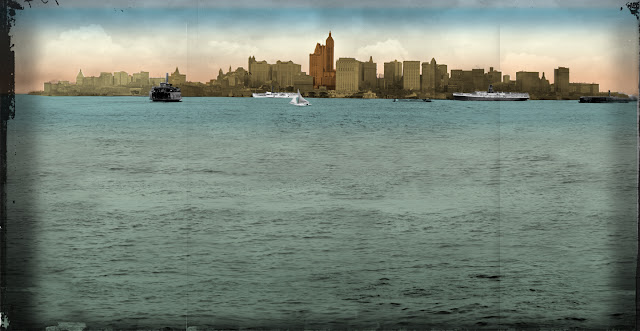Léon Gimpel, Balloon show at the Grand Palais, 1907
Lt Col. Mervyn O'Gorman, his daughter Christina at Lulworth Cove, 1913
O'Gorman was also a pioneering aviator, motorist and Superintendent of the Royal Balloon Factory
O'Gorman was also a pioneering aviator, motorist and Superintendent of the Royal Balloon Factory
 |
| Mrs. Benjamin F. Russell, Lady in a greenhouse, 1910 I cant find any further information about Mrs. Benjamin F. Russell although she has some other unusual autochromes out there. |
 |
| Charles Zoller, Arnett YMCA interior, ca 1916 |
 |
| Charles Spaeth, woman in silk robe, ca 1915 |
 | ||
| Jean-Baptiste-Tournassoud, girl in a hammock, 1909 |
 | |
 |
| Heinrich Kuhn (above two) ca 1910 |
 |
| Anonymous, ca 1915 |
Autochrome, invented by the Lumiere brothers, French moving picture pioneers, was the first industrial process for color reproduction. Thus true color images became next in the line of French landmark inventions beside the daguerreotype and, come to think of it, photography itself. On June 10, 1907 the autochrome became commercially available after Messrs. Lumiere made the first public demonstration. I believe it remained the only color process until the arrival of Kodachrome in 1935.
It was a rather complicated affair to create autochrome plates, and hence, expensive.
It was a rather complicated affair to create autochrome plates, and hence, expensive.
"Microscopic potato starch grains were separated into batches, dyed red, green and violet, mixed together and spread over a glass plate coated with a sticky varnish. Next, carbon black (charcoal powder) was spread over the plate to fill in any gaps between the colored starch grains. A roller submitted the plate to a pressure of five tons per square centimetre in order to spread the grains and flatten them out. Finally, the plate was coated with a panchromatic photographic emulsion....A summer landscape taken in the midday sun, required at least a one second exposure. In cloudy weather, this could be increased to as much as ten seconds or more. Spontaneous ‘snapshot’ photography was out of the question, and the use of a tripod was essential.”—The Royal Photographic Society
Professional photographers and artists were agape and took to autochrome's pointillist effects, which were in perfect step with the romanticized Pictorialist art sensibilities of the day. (Upper middle class hobbyists took to it too, producing floral still lifes ad nauseum.)//
Autochrome colors flicker between hazy indeterminancy and saturated flashes. The images have such an ethereal almost fleeting quality about them, like the partial recollection of a dream. The fugitive aspect is paradoxical of course since these images have been fixed, however precariously, for a hundred years...
........................................... Autochrome colors flicker between hazy indeterminancy and saturated flashes. The images have such an ethereal almost fleeting quality about them, like the partial recollection of a dream. The fugitive aspect is paradoxical of course since these images have been fixed, however precariously, for a hundred years...
further reading:
Steven Kasher gallery
photographymuseum.org
Flickr set
Read about the amazing Albert Kahn collection of some 72,000 autochrome plates—
part of his wildly ambitious attempt at an ethnographic "archive of the planet."
photographymuseum.org
Flickr set
Read about the amazing Albert Kahn collection of some 72,000 autochrome plates—
part of his wildly ambitious attempt at an ethnographic "archive of the planet."
* “It’s the greatest thing that ever happened to photography,” Alvin Langdon Coburn told Alfred Stieglitz in 1907, "I have the color fever badly."
“Soon the world will be color-mad," said Stieglitz.
“Soon the world will be color-mad," said Stieglitz.


















































